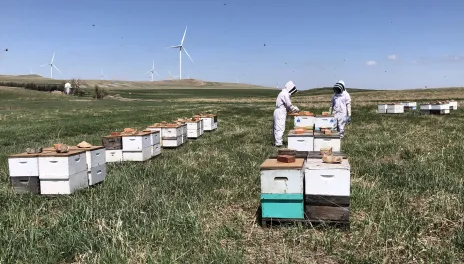HREC Aims to Understand How Honeybees Use Shelterbelts
Each year in May, honeybees begin to return to North Dakota from around the nation where they have been pollinating crops. North Dakota lacks floristic resources for honeybees in early spring. Therefore, beekeepers generally feed their bees, which is an added cost.
“Bees are big business in North Dakota,” says Benjamin Geaumont, Hettinger Research Extension Center (HREC) specialist for wildlife and range research. “North Dakota is the largest producer of honey in the U.S.”
Shelterbelts established throughout much of the Upper Great Plains to conserve soil and provide shelter for wildlife and humans typically include early-season flowering trees and shrubs, which may provide resources for honeybees.
Geaumont and other personnel at NDSU’s main campus and the Northern Prairie Wildlife Research Center in Jamestown are aiming to understand how honeybees use shelterbelts, whether shelterbelts impact the health of the colony, and what specific trees and shrubs are preferred by honeybees.
With a grant from North Central Sustainable Agriculture Research and Education, and with the help of private landowners and private beekeepers, the researchers began their data collection in 2020.
Researchers identified apiaries to evaluate based on the surrounding tree and shrub cover. Four colonies per apiary were selected for study based on colony health assessments. Two hives were set on scales with weight measured hourly throughout the summer. Hives increasing in weight signaled that the colony was producing more honey and producing more worker bees. The other two colonies were set on pollen traps to understand what plants the bees were foraging on during the early-season (mid-May to June). To date, nearly 280 colonies from 70 apiaries across central and southwest North Dakota and northwest South Dakota have been monitored as part of the study.
Preliminary data suggests that trees and shrubs in shelterbelts are used by honeybees. Pollen data suggests that honeybees forage from a variety of plants during the early season, including dandelions, lilac bushes and chokecherry trees.
“The research is ongoing,” says Geaumont. “We hope to provide beekeepers with information that will help them determine where to place bees to take advantage of early season floral resources and make planting recommendations to soil conservation districts and landowners so that pollinator habitat is considered when establishing shelterbelts.”
FOR MORE INFORMATION:
Benjamin Geaumont, 701-567-4323, benjamin.geaumont@ndsu.edu
